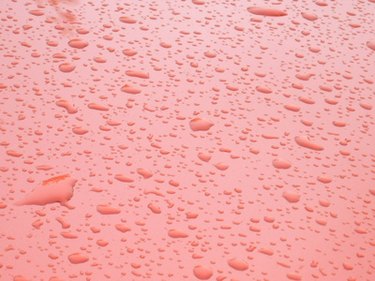Things You'll Need
Sewing machine
Scissors
Tape measure
Fabric
Waterproof fabric (optional)
Single-edge razor blade or utility knife
Shower curtain hooks
Shower rod
Vinyl liner (optional)
Waterproofing spray (optional)

Waterproofing a shower curtain can be as simple as hanging a vinyl liner behind it, using waterproofing spray on tightly woven fabrics, or buying waterproofed fabrics off the bolt. Having a waterproof shower curtain can save the floor and walls adjacent to the shower because the curtain will prevent the water from reaching those surfaces. Having lots of options for the fabric of a shower curtain can individualize a bathroom and make a statement about personal taste.
Step 1
Measure the length and width of the shower or bathtub. Start at the top of the tub or shower and measure to the bottom. Add 3 inches for the top fold to the length. You do not need to add for a hem allowance because shower curtains seldom touch the bathroom floor or the inside of the tub. When they do, molds or mildew can grow on them because of the constant exposure to moisture. Measure the width and decide how much fullness you want in your shower curtain. Add additional width if you want your shower curtain to have a gathered appearance. Most shower curtains measure 72 inches by 72 inches including hems and the fold at the top from which it is hung. Curtains for shower stalls have to be longer to reach the floor. Measure from the rod to the bottom of the stall and add 6 inches for the total length of the fabric.
Video of the Day
Step 2
Look for waterproof or water-resistant fabrics. Some fabrics are water resistant, especially polyesters and sheers. Heavy fabrics made from cotton will absorb quite a lot of water and mold or mildew could be a problem in humid climates. Few fabrics are sold in 72-inch widths, so you will have to double the length to get enough for the two panels unless you are sewing a curtain for a shower stall, in which case you may need just one panel.
Step 3
Cut the fabric, bearing in mind the hem and top fold allowances. Pin the sides together and sew the seam. Press it flat. Lay the top of the shower curtain on the ironing board and press a one-eighth-inch hem toward the wrong side of the fabric. When done, press 3 inches over to form the finished top of the shower curtain. Sew that seam down with the sewing machine. Repeat the process to form the bottom hem of the shower curtain. When finishing the two sides of the shower curtain, you can eliminate the one-eighth-inch fold by using the bound edges of the fabric called selvages. Press a 1-inch fold on both sides and sew them down.
Step 4
Make 12 evenly spaced buttonholes on the top hem of the shower curtain. Since most shower curtains measure 72 inches across, place the button holes every 6 inches, starting at the very edge of the shower curtain. Slit the buttonholes open with a single-edge razor or a sharp utility knife.
Step 5
Waterproof the finished shower curtain according to the instructions on the can if the fabric you use to make the shower curtain is not waterproof or water resistant. Make sure you spray it in a well-ventilated room or outdoors. When the fabric is dry, hang it from the shower rod using the hooks.
Warning
If you buy a liner down the road for your shower curtain, make sure you buy one made from PEVA, not PVC, which has many dangerous volatile organic compounds. PEVA is a type of vinyl made with safe chemicals.
Video of the Day